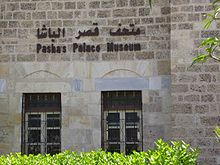- Qasr al-Basha
-
Qasr al-Basha (Arabic: قصر الباشا) (also known as Radwan Castle and Napoleon's Fort) was formerly a large palace, and now a two-floored girl's school and museum, situated in the Old City of Gaza.[1] It served as a seat of power in the Mamluk and Ottoman periods and as a police station under the British Mandate.
Contents
History
Mamluk and Ottoman eras
The first floor of Qasr al-Basha was built by the Mamluk sultan Zahir Baibars in the mid-13th century. The facade bares the landmark of Baibars which is a relief sculpture of two lions facing each other.[2] The geometrical patterns and domes, fan and cross vaults are typical Mamluk architecture under Bahri rule. According to local legend, in the 13th century CE, when Baibars was still a general fighting the Crusaders and Mongols throughout the Levant, he passed through Gaza on several occasions. During one of his visits, Baibars is believed to have married in Gaza and built a grand mansion for his Gazan wife and children. It is said that Qasr al-Basha is what remains of this home.[1]
The second floor of the building is largely of Ottoman-era construction.[2] In the 17th century, Qasr al-Basha served as the fortress home of the ruling Radwan dynasty (hence the name "Radwan Castle") and later pashas of Gaza, who were governors appointed by the Ottoman governor of the Damascus Province.[1] During this era, the fortress was provided with arrow slits and underground passages as means of defense. Within the complex were soldier's lodgings, a mosque, granary, an armory, and cannons. The height of the structure made Qasr al-Basha a strategic point in Gaza. This, along with its fortifications, was the probable reason Napoleon Bonaparte spent three nights at the palace during his Siege of Acre in 1799, hence the name "Napoleon's Fort".[2]
Turkish traveler Eviliya Celebi wrote of Qasr al-Basha in 1649, saying "the Citadel was built in ancient times and destroyed by Nebuchadnezzar. The present citadel derives from a later time. It is small and rectangular and lies one hour distant, east of the sea. Its walls are twenty yards high. It has a metal door which opens in the direction of the qibla. The commander and the garrison must always be present here to fulfill their guard duties because it is in a dangerous place, here the Arab tribes and the enemy are numerous."[2]
Modern period
During the British Mandate of Palestine period it was used as a police station, and during the Egyptian rule of Gaza, Qasr al-Basha was turned into a school known as the Princess Ferial School for Girls. After Farouk I of Egypt were deposed in Cairo, the school was renamed to al-Zahra Secondary School for Girls.[1]
The United Nations Development Programme (UNDP) undertook a project, funded by a grant from the German Development Bank (KFW), for the transformation of Qasr al-Basha into a museum. The UNDP built new facilities for the girls' school, and restoration of the Pasha's Palace began under the close supervision of the Palestinian Authority Department of Antiquities and Cultural Heritage. During the first phase of the project, workers landscaped the museum grounds, installed new doors, windows and gates, and restored the facade of the palace.[2]
In the second phase of the project, display cases and other appropriate furniture was installed in the museum. The Department of Antiquities used them to exhibit some items from their collection, including Roman, Persian, Hellenistic, Phoenician, Ancient Egyptian, and Neolithic artifacts. The smaller building in front of the palace was also renovated for use as a gateway to the museum.[2]
References
Gaza Gaza Topics History · Economy · Education · Tourism
Neighborhoods al-Daraj · Judeide · al-Nasser · Old City · Rimal · al-Sabra · al-Shati Camp · Sheikh Ijlin · Sheikh Radwan · Shuja'iyya · Tel al-Hawa · al-Tuffah · al-Turukman · Zeitoun
Places of Worship Baptist Church of Gaza · Great Mosque · Ibn Marwan Mosque · Ibn Uthman Mosque · Roman Catholic Church of Gaza · Saint Porphyrius Church · Sayed al-Hashim Mosque · Welayat Mosque
Historic buildings ·
Cultural centersAncient Synagogue · Hamam al-Sammara · Gaza Museum of Archaeology · Palestine Stadium · Qasr al-Basha · Qissariya Market · Palestinian Centre for Human Rights · Palestinian Legislative Council · Rashad Shawa Cultural Center · Shuja'iyya Market
Hospitals ·
UniversitiesAhli Hospital · al-Aqsa Hospital · al-Aqsa University · al-Azhar University · Islamic University · al-Shifa Hospital
Public Squares Palestine Square · Unknown Soldier's Square
Streets Ahmad Orabi Street · Izz al-Din al-Qassam Street · Jamal Abdel Nasser Street · Omar Mukhtar Street · Wehda Street
Transportation Port of Gaza
Coordinates: 31°30′15.90″N 34°27′57.48″E / 31.504417°N 34.4659667°E
Categories:- 13th-century architecture
- Schools in the Gaza Strip
- Palaces in the Gaza Strip
Wikimedia Foundation. 2010.

